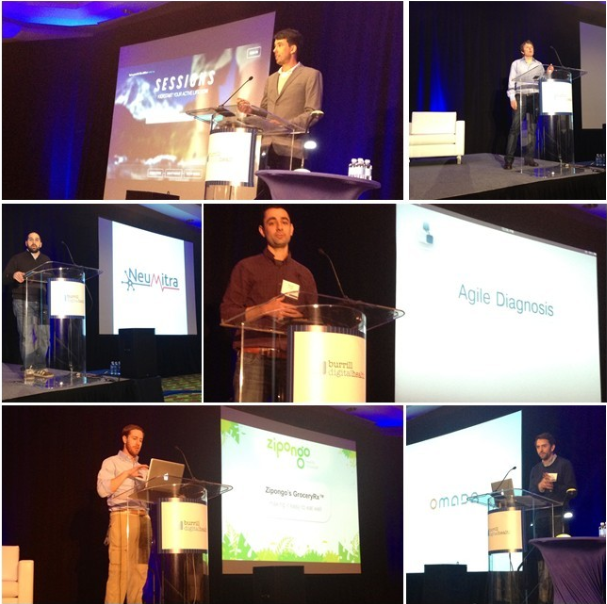What Has Data Done For You Lately?

Current and past Rock Health entrepreneurs presenting at the Burrill Digital Health Meeting on February 5th. In order from top left: Nick Crocker (Sessions), Jason Oberfest (Mango Health), Robert Goldberg (Neumitra), Borna Safabakhsh (Agile Diagnosis), Jason Langheier (Zipongo), and Sean Duffy (Omada Health).
Will all this new health data we’re amassing really, on its own, induce behavior change? The consensus answer is a pretty straightforward no.
Any casual observer of health trends can tell you that the basic data physicians have been sharing in every primary care visit for decades, such as heart rate, blood pressure, blood glucose, and cholesterol levels, have not been enough to motivate the average patient to change her lifestyle. But what about the more personalized, granular information and methods presently growing and democratizing, such as genomics and the so-called Quantified Self?
According to a review article just published in Personalized Medicine, one representative randomized controlled trial of patients with metabolic syndrome found that those provided with genotype data that pertained to their Type 2 Diabetes risk had no greater weight loss, attendance at Diabetes Prevention Program sessions, or motivation to change their health behaviors compared to patients in a control group.
As for self-collected data, many ‘Quantified Selfers’ start tracking their data with the intention of making behavioral changes and seeing how the data are affected (so is the tail wagging the dog?). On the “Wearable Computing and Intelligent Body Scanning” panel at the recent Burrill Digital Health Conference, Fitbit VP Tim Roberts said that while it’s “not just tech geeks” buying their products anymore, their users “come with a certain amount of motivation” that using Fitbit augments. Even among the Selfers present at the meeting (roughly 50% of a few hundred attendees, half of those using wearables), just a handful claimed to have changed their behavior based on the data they’ve collected.
So what tools and implementations might work synergistically with data to create meaningful behavior change? Everyone that spoke at Burrill is trying to figure out the answer to this question in order to do good for patients (and, of course, make money). Some solutions that were discussed, in no particular order:
- Think design: Julia Hu, CEO and Founder of Lark, said that behavior change “takes a lot of design.” That echoed back to a talk by IDEO’s David Webster on day one of the meeting, who talked about how design can (1) Marry and reinforce short- and long-term desires; (2) Create “invisible beginnings” of new behaviors by piggybacking on existing ones; and (3) Make health-enhancing products delightful to use.
- Go social: IDEO’s research finds that people really listen to their social networks. We can utilize sharing to establish new norms.
- Use the evidence base: Omada Health’s ‘Prevent’ leverages data from the landmark NIH Diabetes Prevention Program study, establishing a comprehensive, high-touch program with everything from devices to social networks to health coaches to enact and scale the study’s successful results.
- Gamify: Bringing competition into the mix can spur people into action, but when the novelty wears off, is it sustainable?
- Allow for variable use: During his on-stage demo, Jason Langheier of Zipongo pointed out that people don’t need to monitor their data constantly to benefit from it. He showed how a snapshot of the sodium levels in the food you bought over the past several months could provide diagnostic, actionable information regarding your high blood pressure.
- Make it easy, personal, and low-res: Hu stressed that data collection must be passive. One speaker imagined a scenario in which an AI could tell you that you seem to get anxious when you meet with your boss every morning at 9:00 and, as a result, offer you techniques for stress reduction. It might compute that you’re anxious based on multiple parameters of varying complexity, such as your vital signs, meal patterns, and even genetic predispositions, but if it can synthesize that information to give you guidance that’s personally relevant and stripped down to the minimum necessary, you might keep coming back for more.